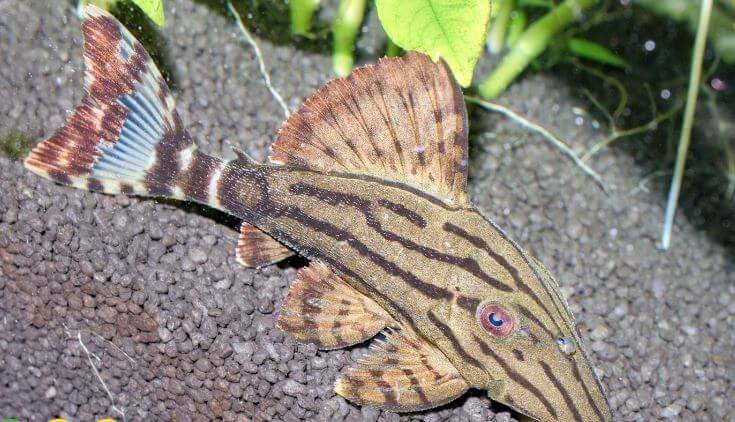The Plecostomus (or Pleco for short) is a popular aquarium fish known for its hardiness and algae-eating habits. But even these sturdy fish can succumb to stress if their tank environment is not maintained correctly. As a Plecostomus aquarist, you need to know the signs of a stressed pleco to take the necessary actions before it’s too late.
The signs of a stressed pleco include erratic swimming patterns, hiding or clustering together, change in coloration, and excessive slime production. When you notice such symptoms, it might mean that the tank has elevated ammonia or the water pH keeps fluctuating.
In the rest of this article, I’ll discuss the main signs of a stressed pleco. I’ll also cover what you should do when your pleco becomes stressed. Keeping reading to find out!
7 Main Signs of a Stressed Pleco
Like any other living organism, Pleco fish require a conducive environment for optimal living. Providing conducive water and pH levels in the tank ensures that the fish has all it needs to survive. However, if the conditions are not conducive for the fish, it will be exposed to stress and display the following signs:
1. Erratic Swimming Patterns
Normally, plecos should swim in a relatively slow and steady motion. Moreover, the fish should not display an upside-down posture when swimming as this is one of the signs of a dying pleco.
However, a stressed pleco fish will swim erratically in all directions. More often than not, a pleco fish will start swimming erratically due to congestion in the tank.
The number of plecos you keep per gallon for efficiency depends on the size of the specific species you have. As a rule of thumb, you need at least a 100-gallon tank (375-liter tank) to maintain a fully grown pleco and avoid congestion.
Another reason your pleco may get stressed and start swimming erratically is high ammonia in the tank. A high concentration of ammonia in the water makes it hard for the fish to excrete ammonia from its body. Consequently, the fish ends up stressed or develops other issues like:
- Damage to the gills
- Reduced immunity
- High respiration rate
- Increased mucous secretion
2. Hiding or Clustering Together
Usually, pleco fish are gregarious. As such, they prefer staying together and will rarely hide away in one corner of the tank. However, when stressed, plecos tend to hide behind rocks or driftwood.
In most cases, the fish will start hiding due to environmental changes. Some of the changes that can occur in the tank and cause the fish to hide due to stress include:
- Altered air flow in the tank due to alterations to the filter
- Change in water temperature or pH levels
- Congestion due to overpopulation
It’s worth noting that plecos will typically hide during the day since they are nocturnal species. However, excessive hiding to the extent that the fish doesn’t swim normally confirms that it’s under stress.
3. Change in Coloration

You may have noticed the change in color of your fish right away. However, if you didn’t see it early enough, be on the lookout for changes in coloration as an indication of a stressed pleco. Usually, a pleco should look dark with bright yellow dots on its body; this is the typical hue of the fish.
However, when stressed, a pleco fish may change its color and appear different than usual due to its body’s defense mechanism.
More specifically, a stressed pleco may have a lighter-colored head with pinky patches on its body and around the mouth. These signs should tell you something is wrong with the fish, and you must take immediate action to salvage it.
4. Excessive Slime Production
Slime is a glycoprotein substance secreted by fish to protect the skin from parasites. Therefore, your fish needs this substance to stay healthy.
Excessive slime secretion indicates that the fish has an underlying condition, in most cases, stress. Too much slime leads to slime disease in the fish. The consequence of this disease is that it stresses the fish more, exposing it to lethal secondary infections like:
- Viral, fungal, and bacterial infections
- Neoplasia
In the case of pleco fish, slime production occurs due to stressful conditions in the tank. For example, when you change the water in the tank or add new decorations.
5. Apathy Towards Food
When you get stressed, it’s normal to refrain from eating. Pleco fish exhibit the same sign when stressed and refuse to eat their regular pellets or other types of food offered.
However, your pleco might be facing an underlying health condition that’s stressing it if it has stopped eating for several days.
A pleco fish that displays apathy towards food while appearing lethargic is ailing and needs immediate medical attention.
However, before consulting a vet, you must ensure you’re feeding the fish the right way. Apart from algae, you should feed it high-quality dried foods, fresh vegetables, and fruits to ensure the fish is getting all its nutritional needs fulfilled.
6. Gasping for Air
If you notice a pleco fish gasping for air on the water’s surface, it’s a sign that the tank lacks sufficient oxygen.
Insufficient oxygen in the tank is a serious condition that can cause death. The condition arises from poor water circulation, which is a result of inadequate filtration.
However, when the fish starts gasping for air, it’s a sign that something has gone wrong in the tank, and there’s more stress than usual. To rectify this issue, follow these steps:
- Check whether you’ve changed the filter recently, as this can cause poor water circulation.
- Ensure there are enough decorations in the tank to help oxygenate the water.
- Avoid overstocking your fish, and change the water frequently to keep it properly oxygenated.
If all these measures fail, consult a vet to get professional advice on how to treat this issue.
7. Scraping Against a Rock or Gravel
A healthy pleco fish should be active and playful at all times. However, as it swims in the tank, it shouldn’t go around scraping, scratching, rubbing, and shaking itself against a rock or gravel.
Such signs indicate a stressed pleco fish. Thus, you must take immediate action to help it recover. The reason behind these abnormal behaviors is that poor water quality in the tank causes skin irritation which is why the fish looks for relief by rubbing itself against epithelial tissue like rocks and gravel.
What to Do When Your Pleco Is Stressed
Every pet owner is happy when their pet is happy and lively. A stressed pleco can also make you, as the owner, stressed. You’re left with many questions than answers, pondering what to do to make your fish happy and lively. Luckily for you, here are some ways to help a stressed pleco:
The first step towards treating your stressed pleco fish is to identify the cause of stress. This will help you direct your efforts in the right direction and refrain from using trial-and-error methods that won’t bare fruit.
In most cases, Plecostomus fish become stressed if environmental conditions in the tank are not ideal. Therefore, you must take steps to prevent stress from occurring and worsening in your fish by:
- Ensuring that the water quality in the tank is optimum: You must provide sufficient filtration by vacuuming regularly t prevent debris from accumulating in the filter. This way, the water will have enough circulation to keep it sufficiently oxygenated.
- Adding buffering agents: Buffering agents like crushed corals and shells are an aquarist’s friend in maintaining optimum pH. These agents balance the water’s pH by mopping up alkalis and acids. Therefore, the chances of your fish getting stressed due to inappropriate water pH are highly eliminated.
- Ensure the fish has sufficient food: Do not leave your pleco to survive on algae alone. Like humans, fish needs a balanced supply of nutrients to stay healthy and prevent issues like getting stressed. As such, you must add earthworms, bloodworms, vegetables, and driftwood regularly in the tank.
- Consider the size of your fish tank: An overcrowded tank exposes the fish to stress as they compete for food and air. Moreover, such a tank doesn’t allow the fish to swim freely as they should. If your plecos are old enough, ensure you have at least 100 gallons of water per fish. Therefore, if you have two plecos, you need a minimum of 200 gallons tank.
- Invest in regular water changes: As an aquarist, you want to keep your pet’s water as clean as possible by changing it regularly. It’s advisable to conduct a 20 percent water change weekly for a larger tank. Remember to dechlorinate tap water before pouring it into the tank. Alternatively, you can leave the water to sit for three days to dechlorinate.
Frequently Asked Questions
Why Is My Pleco Swimming Erratically?
Your pleco is swimming erratically due to overcrowding, poor water conditions, insufficient hiding spots in the tank, injury, trauma, or inappropriate diet. Let’s explore how these factors contribute to erratic swimming among plecos:
- Insufficient hiding spots: Plecos are nocturnal fish. Therefore, they need sufficient hiding spots within the aquarium where they can hide during the day to prevent stress. Inadequate hiding places may make them feel vulnerable, leading to erratic behavior. Therefore, ensure to provide suitable hiding spots like caves, dark pipes, tunnels, wood, and artificial plants in your aquarium.
- Overcrowding: An overcrowded aquarium exposes your fish to insufficient oxygen and internal diseases. It also leads to stress and territorial disputes among fish. Ensure your pleco has enough space and consider the compatibility of other fish in the tank. It’s recommended to keep one plecostomus per tank that can hold no less than 75 gallons of water because these fish can be territorial.
- Insufficient diet: Inappropriate or insufficient diet can also cause erratic swimming in plecos. This is due to the lack of essential nutrients the fish needs for better swimming. Thus, ensure you are feeding your pleco a balanced diet, including appropriate sinking algae wafers or pellets, and provide occasional treats like blanched vegetables.
- Injury or Trauma: Check for any visible injuries or signs of physical trauma on the pleco. This is especially true if you keep more than one pleco in the same aquarium as it can result in fights. Injuries can cause erratic swimming as the fish attempts to escape discomfort.
- Temperature Fluctuations: Rapid changes in water temperature can stress pleco, resulting in erratic swimming behavior. Plecos require water temperatures ranging from 65 to 85 degrees Fahrenheit (18-30°C). Therefore, make sure to maintain the water temperature within this range by keeping your aquarium heater functioning correctly.
How Do You Reduce Stress in Pleco?
You can reduce stress in pleco by ensuring alkalinity between 3° and 10° dKH (54 ppm to 180 ppm) and a water pH between 7.0 and 8.0. Additionally, you should ensure the aquarium water temperature is between 65 to 85 degrees Fahrenheit (18-30°C). You can achieve these pleco water parameters by:
- Testing and monitoring water parameters such as ammonia, pH, temperature, nitrite, and nitrate levels. Ensure these parameters are within the above ranges.
- Performing routine water changes to keep the water clean and free from toxins.
- Installing a good-quality filtration system to maintain water clarity and quality. Plecos are sensitive to changes in water conditions.
- Ensuring an appropriate tank size for your pleco. An adult plecostomus fish requires at least a 75-gallon water tank.
Final Thoughts
A stressed pleco fish indicates an issue that needs your attention. Apart from indicating a problem that requires urgent medical attention, stress in these fish means they are living in an unconducive environment.
Knowing the signs of a stressed pleco will help you take the necessary actions as soon as possible. This way, you’ll intervene and save your lovely pet before it’s too late.

